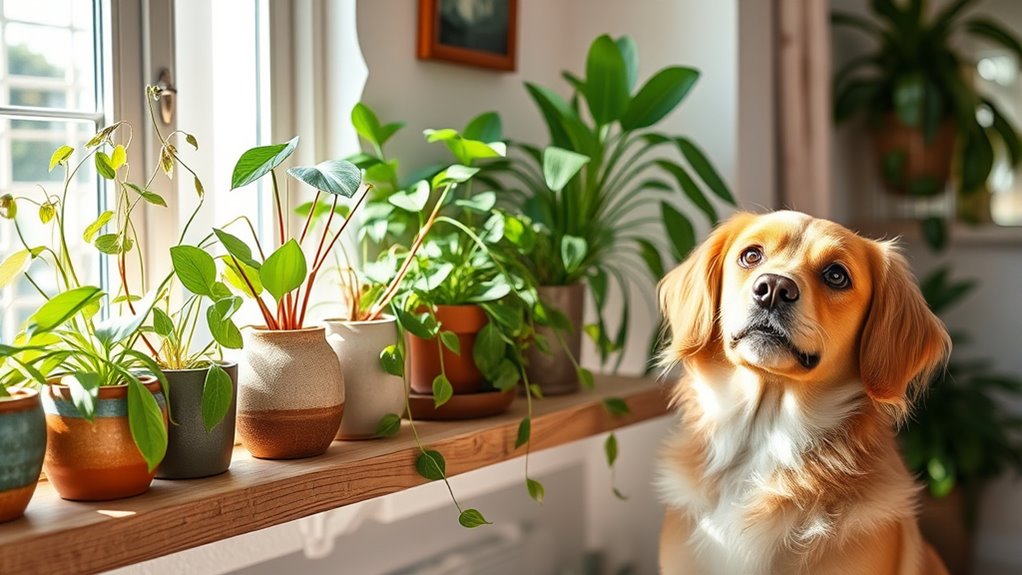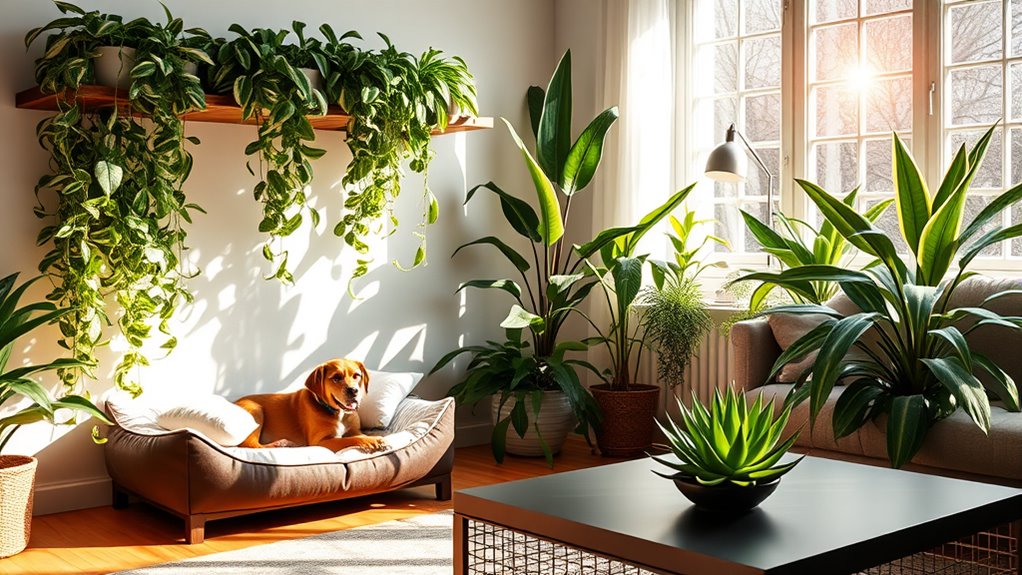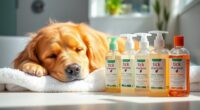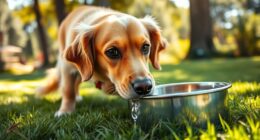To beautify your home safely, choose dog-friendly houseplants like spider plants, Boston ferns, and areca palms. These plants are non-toxic and easy to care for, making them perfect for pet owners. Place them out of your dog’s reach or on elevated spots to prevent chewing. By selecting safe plants and using simple placement strategies, you can enjoy a lush, stylish space without risking your dog’s health—discover more tips ahead.
Key Takeaways
- Choose non-toxic plants like spider plants, Boston ferns, and areca palms to ensure your dog’s safety.
- Verify plant safety labels and avoid common toxic houseplants such as lilies and philodendrons.
- Place plants out of reach or on elevated surfaces to prevent chewing or accidental ingestion.
- Regularly inspect plants for damage and train your dog to respect houseplants as part of home decor.
- Combining pet-safe foliage with strategic placement creates a beautiful, risk-free environment for your home.

If you have a dog and love to decorate your home with plants, choosing dog-safe houseplants is essential to keep your furry friend healthy. You want your space to be beautiful, but it’s equally important to guarantee that your pet isn’t at risk of ingesting toxic plants. Thankfully, there’s a variety of pet friendly foliage that can brighten up your living space without posing health hazards. By selecting non-toxic options, you can create an environment that’s both stylish and safe. It’s helpful to familiarize yourself with toxic plant alternatives so you can confidently choose the right greenery for your home.
Many common houseplants are unfortunately toxic to dogs, but you don’t have to give them up altogether. Instead, focus on pet friendly foliage that’s known to be safe. For example, plants like spider plants, Boston ferns, and areca palms are excellent choices. These plants are not only safe but also easy to care for, making them perfect for busy pet owners. When shopping for new plants, always verify their safety status and look for labels indicating they’re non-toxic to dogs. This way, you minimize the risk of accidental poisoning, which can cause symptoms ranging from mild gastrointestinal upset to more severe health issues.
Many houseplants are toxic to dogs; opt for pet-safe options like spider plants, Boston ferns, and areca palms.
If you’re concerned about the potential dangers of certain plants, it’s wise to replace any toxic plant alternatives in your home. Many popular indoor plants such as lilies, philodendrons, and dieffenbachias are highly toxic to dogs. Removing these from your living space reduces the chance of your pet nibbling on something harmful. Instead, keep your focus on pet friendly foliage that offers the same aesthetic appeal without the danger. For instance, pothos and jade plants can be replaced with more pet-safe options like peperomia or parlor palms. These alternatives provide lush greenery and are safe for curious noses and paws.
In addition to choosing the right plants, placing them strategically can help prevent your dog from chewing or knocking them over. Keep plants out of reach or in elevated spots where your pet can’t access them easily. Regularly inspect your plants for signs of chewing or damage, and train your dog to respect the plants as part of your home décor. This combined approach of selecting pet friendly foliage and implementing preventative measures ensures your home remains both beautiful and safe. Ultimately, by making informed choices about your houseplants, you create a happy, healthy environment for your dog to thrive alongside your beautiful greenery.
Frequently Asked Questions
Are All Pet-Safe Plants Suitable for Outdoor Gardens?
Not all pet-safe plants are suitable for outdoor gardens. You need to take into account their garden compatibility and outdoor care requirements. Some plants thrive in outdoor conditions, while others may need specific sunlight, watering, or soil types. Always research each plant’s needs to ensure they’ll flourish in your garden environment without posing a risk to your pets. Proper selection helps you create a safe, beautiful outdoor space that’s easy to maintain.
How Often Should I Water My Dog-Safe Houseplants?
Think of your houseplants as quiet guardians of your home’s harmony. To keep them thriving, establish a consistent watering schedule that matches their needs—usually once a week, but adapt for indoor conditions. Proper plant hydration guarantees they stay vibrant and healthy, much like a steady rhythm keeps a song alive. Regular watering nurtures your dog-safe plants, creating a lush, worry-free oasis where both your pets and plants flourish.
Can These Plants Be Toxic to Other Pets Besides Dogs?
You wonder if these plants pose toxicity to cats and other pets. While many dog-safe houseplants are generally safe, some can still be toxic to cats or other animals. Always check for specific toxicity to your pets and follow safety precautions, like placing plants out of reach. Research each plant thoroughly to guarantee its safety, and consult your vet if you’re unsure. This helps keep all your pets safe and your home beautiful.
Do Dog-Safe Plants Require Special Soil or Fertilization?
You might worry about special soil or fertilization for dog-safe plants, but generally, they don’t need anything fancy. Most thrive in regular potting soil, and their fertilization needs are minimal—just use a balanced, diluted fertilizer every few months. This simplicity means you can focus on enjoying your plants without extra fuss, knowing they’re safe for your furry friends and easy to care for.
Are There Any Common Household Plants That Are Unsafe Despite Being Dog-Safe?
You might think all household plants are safe, but some common ones can still pose garden toxicity risks despite being labeled dog-safe. Don’t fall for plant safety myths—always verify the specific plant’s safety status. Even safe plants like certain ferns or spider plants can cause issues if ingested in large amounts. To protect your dog, research thoroughly and consult reliable sources, ensuring your home remains both beautiful and safe.
Conclusion
So, now you’re officially a plant parent who’s smarter than the average pet. Who knew that sprucing up your home with dog-safe houseplants could be so easy and safe? No more frantic searches for toxic plants or guilty looks when your pup nibbles a leaf. Just sit back, enjoy your lush, beautiful space, and pretend you’re a plant whisperer—without risking a trip to the vet. Cheers to a greener, safer home for you and your furry friend!










